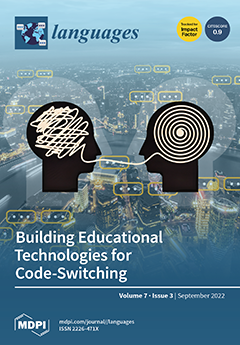The current study investigates self-repairs in the speech of three groups of Russian speakers: monolingual controls (
N = 12) residing in the Russian Federation, for whom Russian is their first dominant language (L1); bilingual Russian–Hebrew speaking participants (
N = 12), who
[...] Read more.
The current study investigates self-repairs in the speech of three groups of Russian speakers: monolingual controls (
N = 12) residing in the Russian Federation, for whom Russian is their first dominant language (L1); bilingual Russian–Hebrew speaking participants (
N = 12), who acquired Russian as their Heritage Language (HL) in contact with the dominant Societal Hebrew in Israel; and bilingual Russian–Chinese speakers (
N = 12) residing in the Russian Federation at the time of testing, for whom Russian is their second language (L2). Picture-elicited narratives were coded for instances of self-repairs, split into Conceptualizer Repairs (C-repairs)—which imply pragmatic, semantic, or lexical changes—and Formulator Repairs (F-repairs), correcting different types of errors. In addition, self-repair initiators—such as cut-offs, hesitation pauses, and discourse markers—were annotated before each instance of self-repair. The results indicate that L2 speakers, in general, use self-repairs more frequently than L1 and HL speakers. L1 speakers hardly produced F-repairs, while HL and L2 speakers resorted to both C- and F-repairs. L1 speakers mainly used C-repairs for appropriacy, whereas HL and L2 speakers used C-repairs for rephrasing and lexical item change. As for F-repairs, HL speakers tended to change pronunciation and morphology, while L2 speakers implemented more morphological repairs. Lexical initiators of self-repairs were more common in L1 speech; however, in the L2 group we saw much more frequent cut-offs of repaired speech fragments. As such, varying self-repair strategies were employed by different speaker groups, shedding light on the underlying processes of language production. There was also evidence of cross-linguistic transfer of non-lexical self-repair initiators: HL speakers resorted to prolongations as initiators in HL-Russian (a strategy that is common in their dominant language, Hebrew), whereas L1 speakers used vocalized and silent pauses more frequently.
Full article





